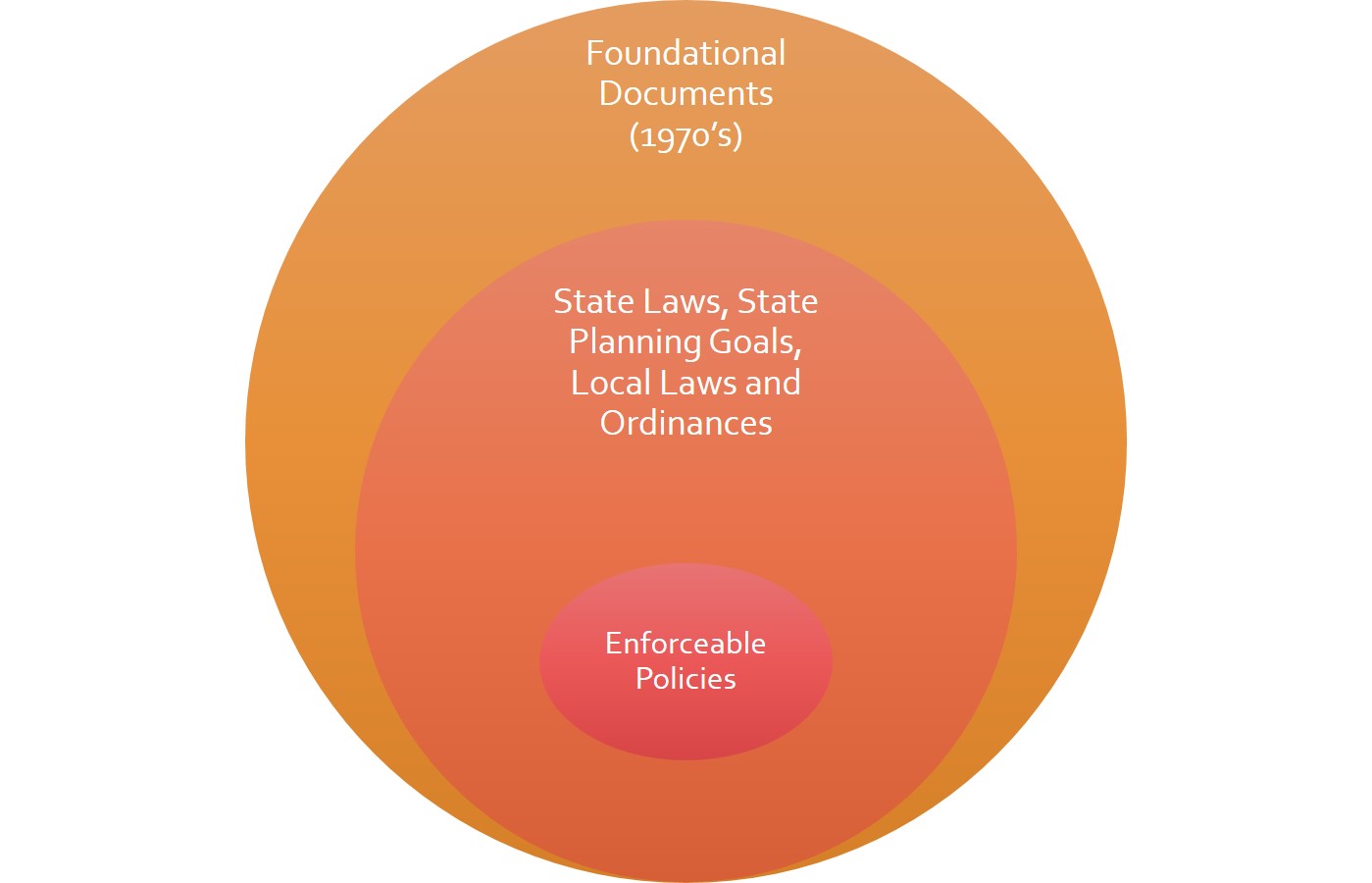The Oregon Coastal Management Program (Program) is made up of 40 partners at the county and city level and 11 state agency partners. Each local entity has documents governing how they operate and guiding how they administer land use in their community. Each state agency has chapters of statutes guiding operations and helping them administer state law. These documents include comprehensive plans and land use regulations, state statutes, and statewide planning goals. DLCD incorporates the documents in their entirety into the Program.
Within the various statutes, goals, plans, and ordinances only certain elements meet the criteria to be used for federal consistency review. These special policies are called enforceable policies. A legal definition of enforceable policies is available in the federal regulations.

Enforceable policies are used during the federal consistency review process. The federal activity is compared to the enforceable policies that apply to it. This review ensures the project is consistent with, or lines up, with the enforceable policies of the management program.
Many of Oregon's enforceable policies are linked to state or local permits. Examples include the Removal-Fill authorization from the Department of State Lands or various land use approvals from the city or county. In Oregon, obtaining state and local permits is the best way to demonstrate consistency, according to Oregon's official administrative rules. If state and local permits are not obtained, as occurs in some federal activity circumstances, the activity must still be consistent with the underlying enforceable policies (§930.39(e)).
Three categories of people use enforceable policies:
- Project applicants and federal agencies applying for federal consistency review must submit an enforceable policies analysis as part of their application.
- People, groups, agencies, tribes and others interested in commenting on a project going through federal consistency review provide comments on the coastal impacts from a project and also how the project is or is not lining up with a particular enforceable policy.
- DLCD must base a federal consistency decision, any conditions, or an objection on the enforceable policies of the management program.
DLCD or our Program partners (cities, counties, and state agencies) select enforceable policies based on an explicit set of criteria. The selected enforceable policies are then submitted to NOAA for approval or disapproval. Anyone that wishes to learn more about enforceable policies can take NOAA's training module. The most recent NOAA approval letters that list approved enforceable policies are located in the tables below.
Enforceable policies are the parts of the Program that are legally binding and can be enforced. For this reason, enforceable policies make up a relatively small part of the management program. Much of the narrative of the management program is policy that provides the framework and rationale for the enforceable policies or are policies that, while used elsewhere can only be applied as recommendations during the federal consistency review process.
Rather than have a fragmented management program with enforceable policies extracted from statutes and local land use plans and codes, DLCD submits the entire related document to NOAA for acceptance and highlights which policies are enforceable.
NOAA generally looks at seven criteria when deciding whether a policy is enforceable.
- Does the policy include mandatory language?
- To be enforceable the policy must contain mandatory language like 'will', 'must', or 'shall'.
- Words like 'recommend', 'encourage', or 'should' are examples of non-mandatory language.
- Does the policy contain a clear standard?
- An enforceable policy can be general, broad, or both, but it must have some definable standard so that it cannot be applied arbitrarily.
- "Only appropriate uses of the waterfront will be approved by the commission," is not a clear standard.
- Is the policy preempted by federal law?
- A policy may already be governed by a federal law that federal agencies are mandated to follow. If that is the case, the policy will not be accepted into the management plan as an enforceable policy.
- Does the policy regulate federal agencies, lands, or waters?
- Enforceable policies cannot attempt to regulate federal agencies, federal lands, or federal waters.
- "Federal agencies are required to…." cannot be an enforceable policy.
- Does the policy discriminate against a particular coastal user or federal agency?
- The enforceable policy must focus on the coastal effect, not a particular user or federal agency.
- For example, allowing transmission lines only if they transfer electricity from renewable sources is discriminating against certain energy producers rather than considering the coastal effect of the transmission line installation.
- Does the policy hinder the national interest objectives of the Coastal Zone Management Act?
- National interest objectives of the Coastal Zone Management Act include coastal-dependent uses like siting major facilities related to national defense, energy, fisheries development, recreation, ports, and transportation.
- For example, an absolute ban on oil and gas production in state waters could be found to be contrary to the national interest objectives of the CZMA.
- Does the policy incorporate other policies or requirements by reference?
- Enforceable policies cannot contain incorporations by reference. A reference to a state or local policy is only approvable as an enforceable policy if the state or local policy itself is also being submitted for approval or has already been approved by the Office for Coastal Management as an enforceable policy.
- It is common and appropriate for local jurisdictions to incorporate plans and policy by reference. DLCD will submit any policy or plan along with selected enforceable policies for approval.
Comparing draft policy or documents to these criteria may be helpful if local jurisdictions or state agencies would like them to be included as enforceable policies in the Program.
To be notified of Program Changes that are submitted to NOAA for approval of selected enforceable policies join our email list.